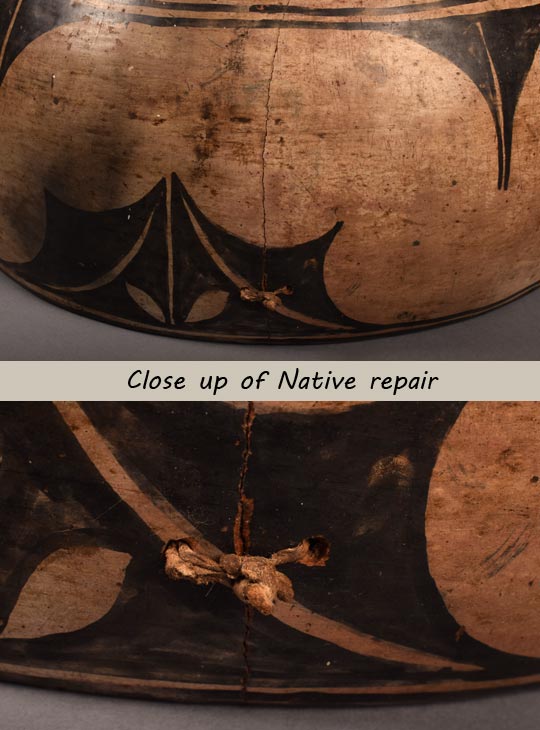Historic Santo Domingo Polychrome Dough Bowl, circa 1900 [SOLD]
+ Add to my watchlist Forward to Friend
- Category: Historic
- Origin: KEWA, Santo Domingo Pueblo
- Medium: clay, pigment
- Size: 9-½” deep x 15" diameter
- Item # C4851A SOLD
This circa 1900 dough bowl is one that was made for and used by the owner at the pueblo for perhaps decades before she allowed someone to purchase it, perhaps in a time of need for funds for some occasion. The bowl developed a lateral crack running down from the rim while it was in use for its daily needs. To continue its usefulness at the pueblo, the owner drilled two holes—one on each side of the crack—and threaded a piece of leather through the holes to secure the crack from further expansion. Pueblo repairs such as this are common and enhance the aesthetic of the pottery.
In its many decades of use at the pueblo, the bowl developed an outrageously beautiful patina on the exterior from the hands of the user, perhaps moving it around daily from place to place. Evidence of use on the interior is equally apparent.
The potters at Kewa Pueblo have a 1500-year tradition of making painted pottery, and during much of that time, decorative styles changed little. Simple black designs painted over a warm cream slip have been the hallmark of the pueblo. This dough bowl is very much in that tradition. The upper two-thirds of the body was covered in bentonite slip, and the lower one-third covered in red slip. The upper section was sparsely designed with black pigment—the designs generally being triangular with variants.
A tradition at the pueblo is, and apparently always has been, to leave an opening in a circle such as the framing line generally seen at the top and bottom of the design panel. This bowl has a black rim, a framing line near the rim, and a framing line at the bottom of the design. A ceremonial line break penetrates the black rim, divides the entire painted body design, and penetrates the lower framing line—a continuous break from top to bottom. There are probably many explanations for such a ceremonial line break, but one often stated is that a completed circle would trap the talent of the artist within and prevent her from continuing as an artist. Her talent must be released.
Kewa Pueblo, with a population of just over 3000 residents, has very few active potters today. It is the largest of the Rio Grande pueblos and is well known for the very large number of participants celebrating the pueblo feast day on August 4th each year. Famous potters of the early twentieth century were the Aguilars (Felipita Aguilar Garcia, Mrs. Ramos Aguilar, and Asuncion Aguilar Cate) who produced magnificent pottery from 1890 to about 1920. From the mid-twentieth century there was Santana Melchor and Monica Silva. Now, the famous name is Robert Tenorio. I am sure there were others of note, but these are the ones with which I am familiar.
By now, most everyone is aware that what was known as Santo Domingo Pueblo is now known as Kewa Pueblo, the true ancestral name before the Spanish assigned the Christian name. What has not changed is the typology name of their pottery—Santo Domingo Pueblo Polychrome—and that is not likely to ever change. We attempt to use the typology name when referring to pottery and the ancestral name when referring to the pueblo.
Condition: very good condition with one native repair of a crack
Provenance: We purchased this Historic Santo Domingo Polychrome Dough Bowl, circa 1900, from a young man in Albuquerque on August 30, 1997. He had inherited it from a friend and chose to sell it at the time. We retained it in the gallery's collection for a quarter of a century until we sold it in 2021. Now we have the pleasure of seeing it again at the gallery, and having it available to sell to another client. It is truly a breathless treat to see it again.
Recommended Reading: A RIVER APART, The Pottery of Cochiti & Santo Domingo Pueblos, Edited by Valerie K. Verzuh, Foreword by Shelby Tisdale, Essays by Bruce Bernstein, J. J. Brody, Antonio Chavarria, Chip Colwell-Chanthaphonh, Mateo Romero, and Valerie K. Verzuh. Published in association with the Museum of Indian Arts and Culture, Santa Fe, NM.
TAGS: Southwest Indian Pottery, Historic Pottery, Cochiti Pueblo, Kewa Pueblo - Santo Domingo Pueblo


- Category: Historic
- Origin: KEWA, Santo Domingo Pueblo
- Medium: clay, pigment
- Size: 9-½” deep x 15" diameter
- Item # C4851A SOLD
Adobe Gallery Recommended Reading
Adobe Gallery Recommended Items
If you are interested in this item, we would also like to recommend these other related items:



